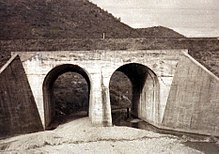The Bridge at No Gun Ri
The book looks in depth at the lives of both the villager victims and the young American soldiers who killed them, and analyzes various U.S. military policies including use of deadly force in dealing with the refugee crisis during the early days of the war.
The next two chapters describe the deployment of U.S. military units to face the onrushing North Korean invaders, the growing nervousness of U.S. commanders who issue orders to fire on South Korean refugee columns out of fear of enemy infiltrators, and the disarray of the weakly led 7th Cavalrymen as they reach the warfront; and then tell of the villagers' plight as they first seek shelter from the war by gathering in a remote area of their valley, and then are forced by retreating U.S. troops to head south toward U.S. lines.
The 26-page middle section is an account of the three days of carnage that began with U.S. warplanes attacking the column of hundreds of refugees, after which survivors were forced into an underpass and machine-gunned until few were left alive among piles of bodies.
In the postwar decades, the psychic toll of what the Koreans suffered and what the Americans did and witnessed weighs heavily on both, leaving them deeply depressed, sometimes suicidal, often haunted by visions and ghosts.
The first describes the AP investigative work that found the U.S. veterans who corroborated the Korean survivors' story and the declassified documents that further supported it, and the bibliographic, archival and interview sources for the book.
[4] On the cover, Pulitzer Prize-winning war correspondent Sydney Schanberg said the book is "in a class to stand with such work as Hersey's Hiroshima and Keneally's Schindler's List … powerful history."
But its publication date of September 6, 2001, came just five days before the 9/11 terror attacks, which jolted the publishing industry, caused the cancellation of the authors' national promotional tour, and dried up the book's promising sales.
[12] The 313-page book, later released in paperback, features 35 photographs, two maps, two charts explaining the U.S. Army command structure in Korea and the villagers' family relationships, and reproductions of three key documents among the many demonstrating the policy of shooting refugees.
The AP journalism had drawn criticism in 2000 when it emerged that one of nine ex-soldiers quoted in the original story was not at No Gun Ri, as purported, but was passing on second-hand information.
